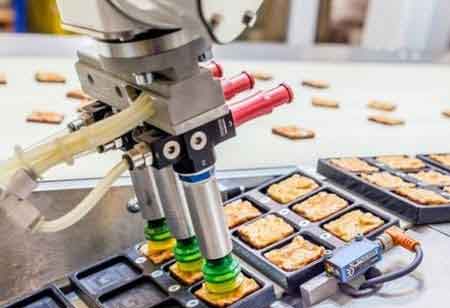THANK YOU FOR SUBSCRIBING
Be first to read the latest tech news, Industry Leader's Insights, and CIO interviews of medium and large enterprises exclusively from Food and Beverage Tech Review
How widely spread is Robotics in Food Manufacturing?
The growth in adapting the latest technological advancements has escalated highly in recent times, as the manufacturers strike hard to stay on top of the global scale production standard.

By
Food and Beverages Tech Review | Thursday, January 23, 2020
Stay ahead of the industry with exclusive feature stories on the top companies, expert insights and the latest news delivered straight to your inbox. Subscribe today.
The growth in adapting the latest technological advancements has escalated highly in recent times, as the manufacturers strike hard to stay on top of the global scale production standard.
FREMONT, CA: The most popular applications being applied in primary and secondary processing are the industrial and collaborative robots in the food industry. Robotic automation has introduced a wide range of application alternations in sectors all over the globe, and out of many, the food processing industry is considered as the final frontier of robotic automation.
Industrial, as well as collaborative robots, can be utilized all through the food supply chain. Traditionally, food processing was one of the most reluctant sectors that ended up difficult to automate. In recent time, the advanced technological advances are prevailing over these obstacles.
High-volume food production has always been a challenge for the robots in the past, which created many obstacles such as shape and size that also made it difficult to grasp the item. Besides, there were the delicate food items that carry stricter requirements, keeping in mind the quality, making them more complicated to pick.
 The introduction of advanced grippers in robotic technology for food processing is considered as one of the most innovative step-forwards. Now, industries have soft grippers that can gently take care of the sensitive food products and grasp them quickly. Furthermore, there are more varieties of grippers like the vacuum gripper, which delicately handles the product, even when irregularly shaped. Several advanced grippers are paired with secure robotic vision technology that helps to guide the robotic arm and enabling it to compensate for product shape irregularities, with greater consistency and accuracy in processing applications.
The introduction of advanced grippers in robotic technology for food processing is considered as one of the most innovative step-forwards. Now, industries have soft grippers that can gently take care of the sensitive food products and grasp them quickly. Furthermore, there are more varieties of grippers like the vacuum gripper, which delicately handles the product, even when irregularly shaped. Several advanced grippers are paired with secure robotic vision technology that helps to guide the robotic arm and enabling it to compensate for product shape irregularities, with greater consistency and accuracy in processing applications.
Considering primary and secondary food processing, robotic automation can be efficiently used in more than one way. Such as:
• Cleaning and maintenance of safe working environments
• Cake decorations
• Cutting and slicing of meat
• Grabbing and placing fruits and vegetables
Food processing has been a subtle industry for robotic technology for a decade. The difficulties that survive in the food products have barred the widespread adoption of robotic technology. However, today, the recent development in technology has led to the increasing use of robotics in the food and beverage industry.
I agree We use cookies on this website to enhance your user experience. By clicking any link on this page you are giving your consent for us to set cookies. More info







